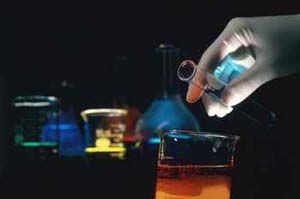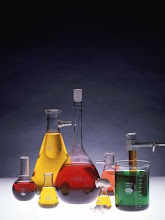What is a plant pigment ?In biology, a pigment is any material resulting in color of plant or animal cells.
Among the most important molecules for plant function are the pigments .
Plant pigments include a variety of different kinds of molecules.
All biological pigments selectively absorb certain wavelengths of light while reflecting others. the light that is absorbed may be used by the plant to power chemical reactions , while the reflected wavelengths of light determine the color the pigment will appear to the eye. Pigments also play important role in plant metabolism and attracting pollinators
Classification of plant pigments
Plant pigments are classified according to its location in the plant cell into two types:
1- pigments of cell sap
2- pigments of plastids
Pigments of cell sap (vacuole)
The cell vacuole:
a large, membrane-bound space within a plant cell that is filled with fluid. Most plant cells have a single vacuole that takes up much of the cell. It helps maintain the shape of the cell.
The vacuole contains pigments dissolving in water and these pigments are responsible for the color of fruits and the flower petals.
They have no relations with the metabolism.
These pigments can act as pH indicators and they can be extracted by using a diluted acidic medium.
Examples of these pigments are anthocyanin and tannins.
It may appear red, purple or blue according to the pH.
Anthocyanins belong to a parent class of molecules called flavonoids
Anthocyanins occur in all tissues of higher plants specially in flowers and fruits.
About 100 different anthocyanins are known
In flowers, bright reds and purples are adaptive for attracting pollinators. In fruits, the colorful skins also attract the attention of animals, which may eat the fruits and disperse the seeds.
Anthocyanins are more abundant in blueberry, cranberry, rubus, cherry &concord grape.
Anthocyanins are less abundant in banana , pear &potato.

Tannins
Tannins are astringent, bitter plant polyphenols that shrink proteins. Plant usually use them as Defensive tastes.
Tannins are found in leaf tissues, bud tissues, seed tissues, root tissues and stem tissues. They don't interfere with the metabolism process in plant but they are described as interfering with digestive processes, and until more effective synthetics were found, were used to tan animal hides and turn them into leather .
The tea plant is an example of a plant said to have a naturally high tannin content.
The sensation of astringency is caused by the ‘tanning’ of the proteins in the saliva and mucous membranes of the mouth; lubrication is reduced and the surface tissues actually contract .
But if you add milk to your tea, the tannins attack the proteins in the milk rather than those in your mouth, and the taste is much less astringent .
Many fruits have a tannin pigment such as
Pomegranates
Persimmon
Tannin is also found in chocolate. The usual concentration is around 10mg per ml in the liquid form.
Tannins are usually divided chemically into hydrolyzable tannins and condensed tannins.
Condensed tannins are polymers of 2 to 50 (or more) flavonoid units that are joined by carbon-carbon bonds, which are not susceptible to being cleaved by hydrolysis
.
Hydrolyzable tannins (decomposable in water, with which they react to form other substances), yield various water-soluble products, such as gallic acid and protocatechuic acid and sugars. Gallotannin, or common tannic acid, is the best known of the hydrolyzable tannins.
Pigments of plastids�(photosynthetic pigments)
Plastids are the major organelles found in plants and algae. Plastids often contain pigments used in photosynthesis.
Photosynthetic pigments are the means by which the energy of sunlight is captured for photosynthesis. However, since each pigment reacts with only a narrow range of the spectrum, there is usually a need to produce several kinds of pigments, each of a different color, to capture more of the sun's energy.
photosynthetic pigments
1-Soluble in organic solvents(Chlorophylls
Carotenoids )
2-Soluble in water (phycobilins)
Chlorophylls
Chlorophyll is the most common pigment present in every plant that performs photosynthesis.
There are various types of chlorophyll but the most common are:
chlorophyll a chlorophyll c
chlorophyll b
Chlorophyll a absorbs well at a wavelength of about 400-450 nm and at 650-700 nm; chlorophyll b at 450-500 nm and at 600-650 nm.
Chemically chlorophylls are pigments which contain a porphyrin ring, a magnesium atom and a hydrocarbon tail .
This is a stable ring-shaped molecule around which electrons are free to migrate. Because the electrons move freely, the ring has the potential to gain or lose electrons easily, and thus the potential to provide energized electrons to other molecules. This is the fundamental process by which chlorophyll "captures" the energy of sunlight.
Chlorophyll a
It is a blue-green pigment. This is the molecule which makes photosynthesis possible, by passing its energized electrons on to molecules which will manufacture sugars
Chlorophyll b
It is a yellow-green pigment.
It has the shown structure.
It occurs only in green algae.
Chlorophyll c
found only in photosynthetic kind of organisms found in aquatic ecosystem
e.g. Chromista and dinoflagellates.
There are 2 types of chlorophyll c:
chlorophyll c1
chlorophyll c2
Carotenoids
They are usually red, orange, or yellow pigments, and include the familiar compound carotene, which gives carrots their color. These compounds are composed of two small six-carbon rings connected by a "chain" of carbon atoms. As a result, they do not dissolve in water, and must be attached to membranes within the cell. Carotenoids cannot transfer sunlight energy directly to the photosynthetic pathway, but must pass their absorbed energy to chlorophyll. For this reason, they are called accessory pigments.
Phycobilins
are water-soluble pigments, and are therefore found in the cytoplasm, or in the stroma of the chloroplast. They occur only in Cyanobacteria and Rhodophyta.
Phycobilins are not only useful to the organisms which use them for soaking up light energy; they have also found use as research tools. Both pycocyanin and phycoerythrin fluoresce at a particular wavelength. This means that when the strong light falls on phycobilins they absorb light energy and release this energy by emitting light of shorter wave length, giving a fluorescent effect.
They are unique among the photosynthetic pigments in that they are bonded to certain water-soluble proteins, known as phycobiliproteins. Phycobiliproteins then pass the light energy to chlorophylls for photosynthesis. The phycobilins are especially efficient at absorbing red, orange, yellow and green light, wavelengths which are not well absorbed by chlorophyll a
Phycobilins may chemically considered as a class of light-sensitive ligands bound to phycobiliproteins and used as accessory light-gathering pigments in algae. The mechanism is described in the entries for phycobiliprotein and phycobilisome. The phycobilins are, like chlorophyll, tetrapyrrole structures. However, unlike chlorophyll, the pyrrole rings are laid out linearly. The detailed structure of four phycobilins commonly found in algae are shown in the next figure
Phycobiliproteins
water soluble fluorescent proteins derived from cyanobacteria and eukaryotic algae. In these organisms, they are used as accessory pigments for photosynthetic light collection. They absorb energy in portions of the visible spectrum that are poorly utilized by chlorophyll and, through fluorescence energy transfer, convey the energy to chlorophyll at the photosynthetic reaction center. ... The phycobiliproteins are composed of a number of subunits, each having a protein backbone to which linear tetrapyrrole chromophores are covalently bound. All phycobiliproteins contain either phycocyanobilin or phycoerythrobilin chromophores, and may also contain one of three minor bilins; phycourobilin, cryptoviolin or the 697-nm bilin
phycobilisome
The phycobiliproteins in many algae are arranged in subcellular structures called phycobilisome.

 Including something new in a food isn’t always a good idea, especially when it comes to your health. Here are 12 additives to subtract from your diet:
Including something new in a food isn’t always a good idea, especially when it comes to your health. Here are 12 additives to subtract from your diet:









